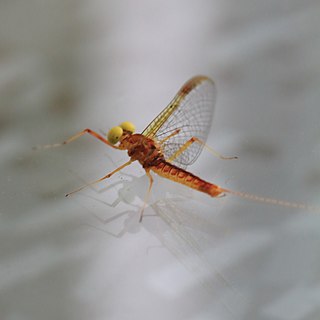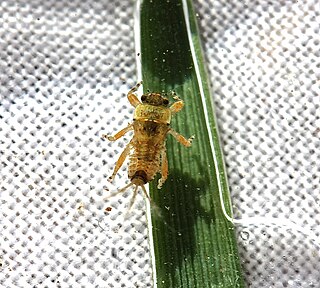
Ammophila is a genus of flowering plants consisting of two or three very similar species of grasses. The common names for these grasses include marram grass, bent grass, and beachgrass. These grasses are found almost exclusively on the first line of coastal sand dunes. Their extensive systems of creeping underground stems or rhizomes allow them to thrive under conditions of shifting sands and high winds, and to help stabilize and prevent coastal erosion. Ammophila species are native to the coasts of the North Atlantic Ocean where they are usually the dominant species on sand dunes. Their native range includes few inland regions, with the Great Lakes of North America being the main exception. The genus name Ammophila originates from the Greek words ἄμμος (ámmos), meaning "sand", and φίλος (philos), meaning "friend".

Mayflies are aquatic insects belonging to the order Ephemeroptera. This order is part of an ancient group of insects termed the Palaeoptera, which also contains dragonflies and damselflies. Over 3,000 species of mayfly are known worldwide, grouped into over 400 genera in 42 families.

Baetis is a genus of mayflies of the family Baetidae, known as the blue-winged olive to anglers. There are at least 150 described species in Baetis. They are distributed worldwide, with the most variety in North America and northern Europe.

Heptagenia is a genus of flatheaded mayflies in the family Heptageniidae. There are at least 20 described species in Heptagenia.

Rhithrogena is a genus of flatheaded mayflies in the family Heptageniidae. There are at least 150 described species in Rhithrogena.

Stenacron is a genus of mayfly in the family Heptageniidae, with a distribution across eastern North America.

Cloeon dipterum is a species of mayfly with a Holarctic distribution. It is the most common mayfly in ponds in the British Isles and the only ovoviviparous mayfly in Europe. Males differ from females in having turbinate eyes.
Neoephemera is a genus of large squaregill mayflies in the family Neoephemeridae first described by McDunnough (1925). and containing approximately six described species in Neoephemera.

Baetiscidae is a family of mayflies. It contains a single extant genus, Baetisca, native to North America with around 12 species. The family is noted for their spined armoured larvae, which live in flowing water pools and on the edges of streams where they are detritivores, consuming fine particles of organic matter. Two other extinct genera are known, extending back to the Early Cretaceous. They are closely related to Prosopistomatidae which have unusual, beetle-like nymphs as well as the extinct genus Cretomitarcys, with the three groups constituting the clade Carapacea.
Ametropodidae is a family of mayflies in the order Ephemeroptera. There are at least three genera and three described species in Ametropodidae.
Litobrancha is a genus of common burrower mayflies in the family Ephemeridae. There is at least one described species in Litobrancha, L. recurvata.
Anthopotamus is a genus of hacklegilled burrower mayflies in the family Potamanthidae. There are at least four described species in Anthopotamus.
Anthopotamus distinctus is a species of hacklegilled burrower mayfly in the family Potamanthidae. It is found in southeastern Canada and the eastern United States.
Anthopotamus myops is a species of hacklegilled burrower mayfly in the family Potamanthidae. It is found in southeastern Canada and the eastern United States.
Anthopotamus verticis, or Walker's tusked sprawler, is a species of hacklegilled burrower mayfly in the family Potamanthidae. It is found in southeastern Canada and the northern and southeastern United States.
Homoeoneuria is a genus of brushleg mayflies in the family Oligoneuriidae. There are at least 5 described species in Homoeoneuria.

Pisciforma is a suborder of mayflies in the order Ephemeroptera. There are at least 410 described species in Pisciforma.

Ephemerella is a genus of spiny crawler mayflies in the family Ephemerellidae. There are about 19 described species in Ephemerella.
Procloeon rubropictum is a species of small minnow mayfly in the family Baetidae. It is found in the south half of Canada and the eastern United States.
Ammophila ferruginosa is a species of thread-waisted wasp in the family Sphecidae.








